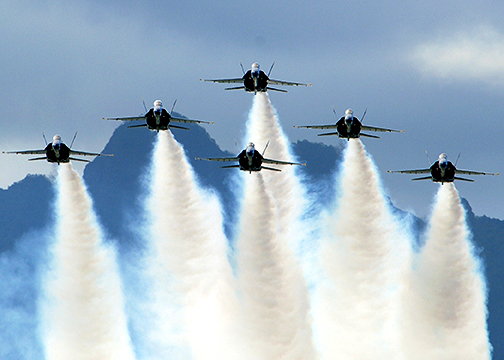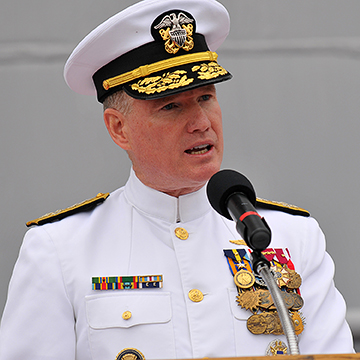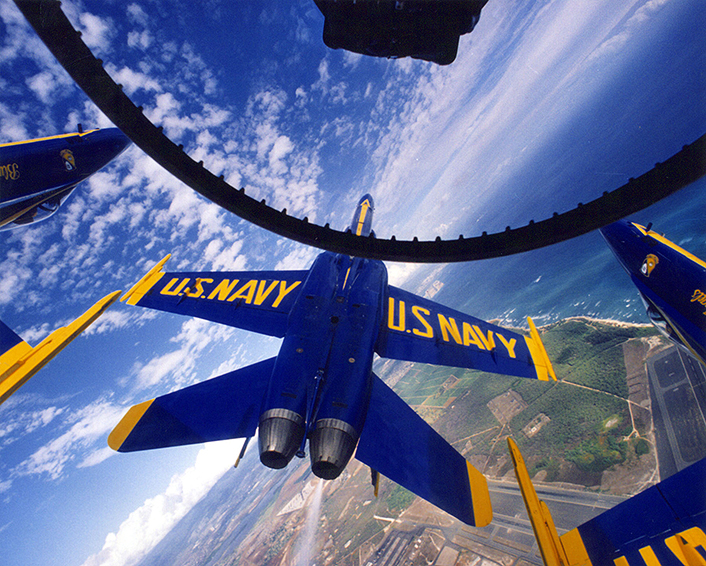
The Blue Angels perform a delta formation at an air show in Hawaii. The squadron performs about 30 maneuvers during a typical aerial demonstration.
Retired four-star Adm. Patrick M. Walsh of Dallas will discuss his experience as a combat pilot and member of the Navy’s precision Blue Angels flight squadron in a sold-out public lecture Saturday, July 13.
The presentation, “The Blue Angels 1987-1988: A Season in Transition,” is this year’s George W. Jalonick III and Dorothy Cockrell Jalonick Distinguished Memorial Lecture. The talk is presented by the Eugene McDermott Library’s Special Collections department, which houses the University’s History of Aviation Collection.
Walsh retired in 2012 after a career that included assignments as vice chief of naval operations and commander of the U.S. Pacific Fleet, the largest fleet in the world.
His UT Dallas talk will focus on his time with the Blue Angels, when the squadron switched the type of aircraft it was using in its famous close-formation flight demonstrations. He will talk about the air show environment, the handling qualities of the aircraft and more.
In advance of the lecture, Admiral Walsh answered a few questions about his career.

Adm. Patrick M. Walsh of Dallas will lecture on his experience as a member of the precision squadron.
In the middle of a Blue Angels show season, you and fellow Blue Angels pilots found yourselves switching from the smaller A-4F Skyhawk to the F/A-18 Hornet A/B without the benefit of off-season training. What was the most difficult adjustment you had to make in the larger, more powerful plane?
“I was responsible for the team's transition to the new aircraft. … The most difficult adjustments in the transition had to do with speed control and roll rate. There were significant differences in performance characteristics between the two aircraft. Our challenge was to make sure that all six pilots were able to master the new aircraft in the demonstration environment.”
You flew in positions No. 3 (left wingman) and No. 4 (slot pilot), in the Blue Angels. How did these positions differ from the others?
“One difference for our team was the progression in the formation during a two- or three-year tour of duty. The left wingman would stay focused on the left side of the flight leader's aircraft for the entire year and then move into the slot the following year. Then, the slot pilot would be responsible for training the left wingman (who is usually a first year or newbie pilot) as well as the back-up safety of each maneuver, monitoring the flight leader and maneuver parameters (checking airspeed, altitude, roll rate, etc.).”
What is your reaction to the cancellation of the entire Blue Angels show season this year because of the legislative sequester that eliminated funding for the program?
“We are losing more than the Blue Angel show season with the 2013 sequester — there are significant fleet-wide impacts that affect the maintenance of ships, submarines, and aircraft as well as the readiness of the equipment and operators. This issue is unprecedented in its significance and impact to all of the services.”
Were you aware that another admiral from Texas – five-star Adm. Chester W. Nimitz – ordered the creation of the Blue Angels in 1946 when he was Chief of Naval Operations?

The Blue Angels are stationed in Pensacola, Fla., and have been performing air shows since the group was established in 1946.
“Yes, Nimitz is one of those historical figures that continues to grow in stature over time. He was a remarkable man of great vision.”
A previous presentation in the Jalonick Memorial Lecture Series focused on commercial and Air National Guard pilots during the chaos of Sept. 11, 2001. What are your memories of that day from your location near the Pentagon?
“I was in the Navy Annex on Columbia Pike across the street from the Pentagon. The geometry of the aircraft put us underneath the flight path of AA#77. … We felt the aircraft cross over our building and heard the noise of the engine in the seconds prior to impact. It is a day, a time and memory still fresh in my mind.”